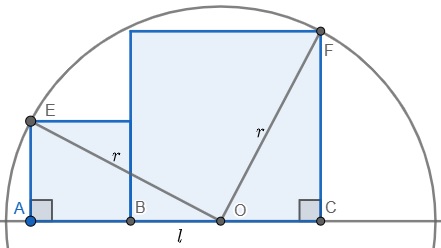I had to stare at this one a long time to solve this one! I have created a diagram below with points labeled so that it is easier to follow along.

In the diagram above, notice that OF and OE are both radii of the semicircle. These lengths I have labeled as r. I have labeled L as the length of segment OB. We can now apply Pythagorean's Theorem twice to find the radius of this semicircle.
| \(r^2 = {\rm AE}^2 + ({\rm AB} + l)^2 \\ r^2 = 2^2 + (2 + l)^2\) | \(r^2 = {\rm CF}^2 + ({\rm BC}^2 - l)^2 \\ r^2 = 5^2 + (5 - l)^2\) |
Now, we have expressions for both r and L, so we can solve for r, and we are finished. Probably the best way is to solve for L first since that one is easier to solve.
\(2^2 + (2 + l)^2 = 5^2 + (5 - l)^2 \\ 4 + 4 + 4l + l^2 = 25 + 25 - 10l + l^2 \\ 8 + 4l = 50 - 10l \\ 14l = 42 \\ l = 3\)
Now that we have solved for L, we can find the radius.
\(r^2 = 2^2 + (2 + l)^2 \\ r^2 = 2^2 + (2 + 3)^2 \\ r^2 = 4 + 25 \\ r^2 = 29 \\ r = \sqrt{29} \text{ or } r = -\sqrt{29}\)
Since we are dealing with the radius, which is a length, we should reject \(r = -\sqrt{29}\). Therefore, \(r = \sqrt{29} \approx 5.3852\)
.